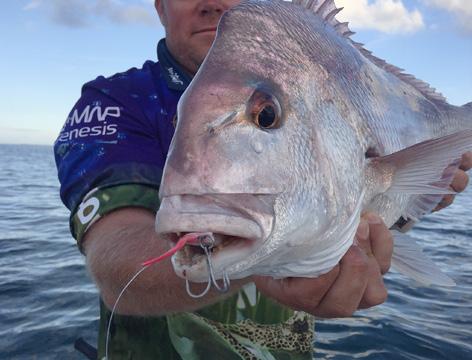North Coast
WA
April crabs are coming DAMPIER/KARRATHA
Troy Honey
The Karratha wet season came to a halt after the good rains we saw in February, so the river
seen some good rains inland in the Pilbara, which has helped bring the landscape into colour, but all along the coast is very dry. However, there’s still a chance of a late cyclone or tropical low, so fingers crossed we finish
further north around Cossack and Point Samson, as well as further north at Balla Balla, have been much more productive this season than the Karratha creeks, both in fish size and quantity. The build-up to
Ricky Mclean with a night-time barra caught in the Karratha region. days we have had. On the larger spring tides that stir the white water up, large poppers cast and retrieved at speed over
20kg mark. Amongst the GTs there has been plenty of queenfish getting in on the action, as well as a few solid coral trout that
this will taper off towards the end of the month and then the demersal fishing will gain traction amongst the locals and tourists.
Ricky Mclean displays the tackle he uses to entice and land Karratha barra. and creek systems haven’t seen the kind of flow they received in previous years. The barra season as such has been relatively slow, although with the lack of cyclones and strong flows there has been a wider spread of fishing days, because the fishing hasn’t been shut down by storms.
the season off with some heavy falls. Water temperature near shore and in the creeks averaged 32.5°C from mid-February to mid-March, which has been ideal for barra fishing. A handful of locals have been very successful despite the struggle of the wider spread
the spring tides, especially on the new moon, have fished extremely well. Fishing these systems can be challenging on spring tides, due to the times the boat can be launched and retrieved as well as moving about in the creeks on the low. However, by putting in the hours and timing the tides right, the success rate is substantially higher. On the pelagic front, March has been massive in the Dampier Archipelago and the Montebello Islands, with multiple great catches of large GTs, Spanish mackerel and longtail tuna. All the common areas are fishing well, especially over the shoals where trolled lures have been deadly for the Spanish mackerel on the many calm and clearwater
Ricky boated quite a few barra in the 600-800mm range during a weekend out in March. the water wash has proved to be the most successful for hooking up on the GTs. Many have been over 15kg, with a few exceeding the
couldn’t resist the lures. As we head into April, we will see barra and the pelagics still being caught in the warmer conditions, but
The huge spring tides in March brought out the mud crabs. The author found quite a few in the Mardie creeks south of Karratha. The forecast for the 2021/2022 season was for a greater number and severity of cyclones due to La Niña, but that forecast from the Bureau of Meteorology has not eventuated. We have 120
APRIL 2022
of anglers who have fished Karratha and surrounds. Nickol and Airport creeks have been fair at best, with most barra landed in the 500-700mm range. The creek systems
Night-time is ideal when chasing barra in the Karratha region. Coryn Bradley knows the secret spots the barra can be found at night, and regularly lands solid specimens.
Demersals are still being caught, and quite a few red emperor and saddletail seaperch have been landed from waters 40m or more in depth, with the new moon spring tides being the most productive time. Brightly coloured jigs and vibes are working well on the reds, and have the added benefit of not being as attractive to sharks. Closer to shore in depths from 15-30m, the blueline emperors have been firing. Amongst them the chinamanfish have started turning up, as they always do in March each year. Coral trout are being caught in all depths, from 5m through to 50m, and there seems to be no stopping their relentless attacks on baits, jigs and lures. This is a great problem to have, except when being caught in deeper waters, where they are retrieved quickly to minimise shark losses To page 121











































